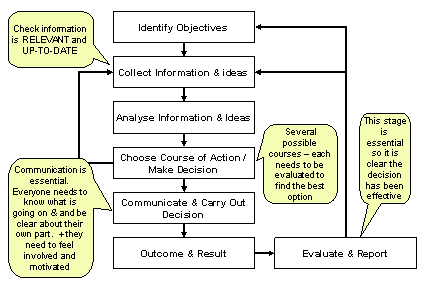|
|
COPYRIGHT 2008 LOVELYWENGJOAN. ALL RIGHTS RESERVED. |

DECISION MAKING IN BUSINESS AND MANAGEMENT |
page 2 of 2 |
Types of Business Decisions 1. Programmed Decisions These are standard decisions which always follow the same routine. As such, they can be written down into a series of fixed steps which anyone can follow. They could even be written as computer program Figure 1: Levels of Decision-Making Figure 2: The Decision-Making Process The model in Figure 2 above is a normative model, because it illustrates how a good decision ought to be made. Business Studies also uses positive models which simply aim to illustrate how decisions are, in fact, made in businesses without commenting on whether they are good or bad. Linear programming models help to explore maximising or minimising constraints eg one can program a computer with information that establishes parameters for minimising costs subject to certain situations and information about those situations. Spread-sheets are widely used for ‘what if’ simulations. A very large spread-sheet can be used to hold all the known information about, say, pricing and the effects of pricing on profits. The different pricing assumptions can be fed into the spread-sheet ‘modelling’ different pricing strategies. This is a lot quicker and an awful lot cheaper than actually changing prices to see what happens. On the other hand, a spread-sheet is only as good as the information put into it and no spread-sheet can fully reflect the real world. But it is very useful management information to know what might happen to profits ‘what if’ a skimming strategy, or a penetration strategy were used for pricing.
|
|
Next Topic: Decision Making Procedure |
|
Previous Topic: Definition of Decision Making |
go to page 1| <<Back |


